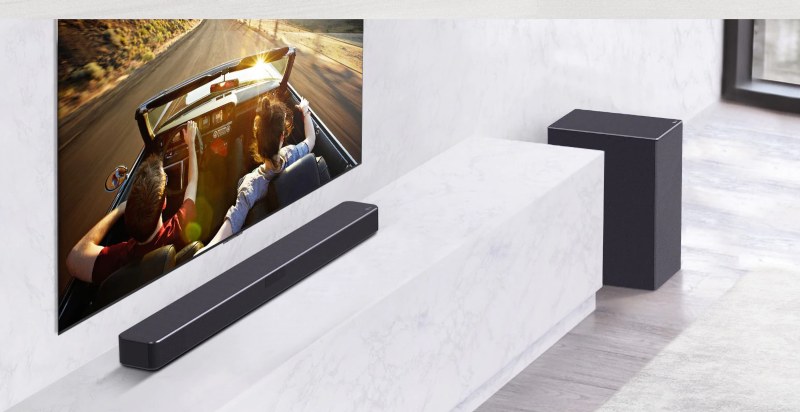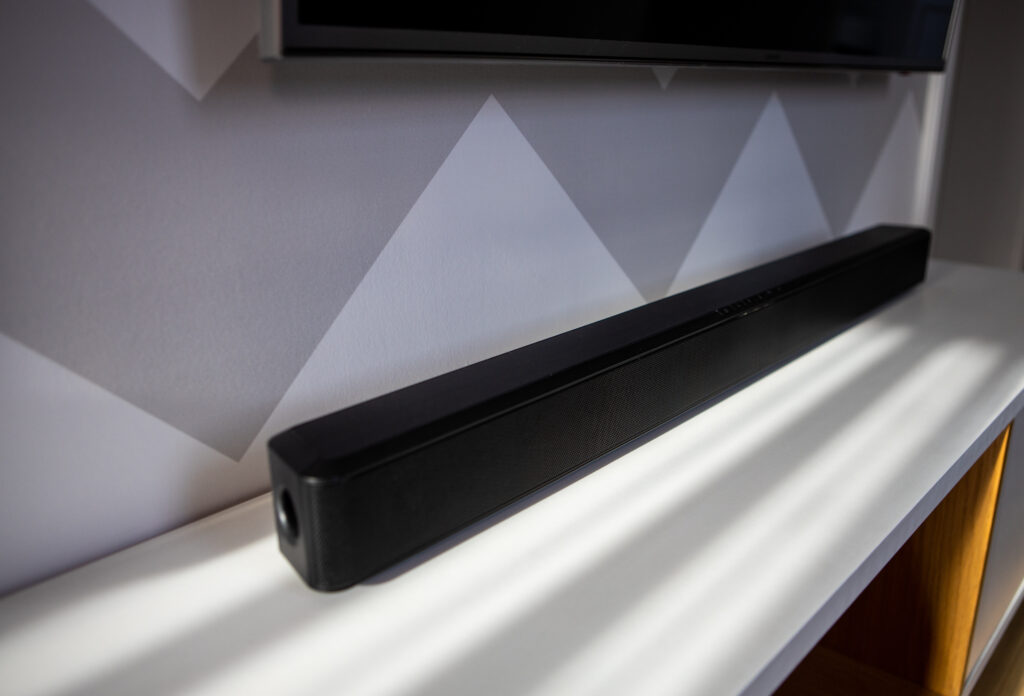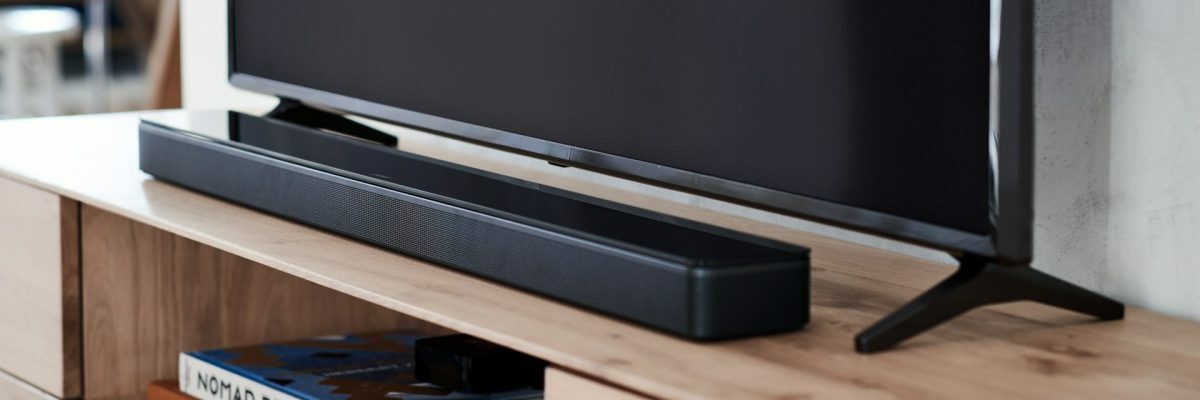Cinematic Marvels: Best Home Theater Systems
Do you want a cinema experience in the comfort of your home? Home theaters are audio systems that provide great surround sound–just like the cinema! If you would love to get one, check out some of the best ones we researched and picked for your consideration.
Samsung HW-A550/ZC 2.1CH 410W 5 Speakers Sound Bar with Wireless Subwoofer [Canada Version] (2021)
Best overall
Buying the Samsung HW-A550/ZC means you get a soundbar and a wireless subwoofer for quality sound and deep bass. It comes with a remote for power, adjusting volume, and choosing sound effects.
Pros
- Soundbar with wireless subwoofer
- Surround sound technology
- Deep and consistent bass
- Remote control included
- Supports Bluetooth pairing
Cons
- The Manual is not detailed enough
- Few users found it challenging to insert batteries in the remote
Review
The Samsung HW-A550/ZC comprises a sound bar and a wireless subwoofer, the ultimate combination for clear, rich sounds.
You don’t get quality sounds alone; using the bass boost feature, the subwoofer delivers rich and deep bass to accompany the theater sounds. The soundbar is about 41” long, and you can place it on your console or mount it on the wall.
The soundbar and subwoofer weigh 2.1kg and 5kg, respectively, and their black finish makes them blend with any decor accent you may already have.
More importantly, this home theater delivers Dolby DTS audio with 3D surround sound, courtesy of the soundbar’s five speakers, to make the sounds from music or movies realistic and immersive, similar to that of the cinema.
Additionally, the soundbar has an Adaptive Sound Lite feature that utilizes sensors in the bar to detect and adjust parameters for the best sound experience. That’s not all; it supports a game mode that automatically detects when you’re playing games and adjusts its parameters to deliver the best gaming sounds.
A remote is included for turning the device on or off, adjusting volumes, and tweaking sound effects; this OneRemote works for all Samsung devices, including TVs. The HW-A550/ZC does not support WiFi; instead, it uses Bluetooth for connectivity together with ports like HDMI (2), USB (1), optical audio input (1), and power (1).
Despite these pros, several users complained the instructions in the manual needed to be clearer and more detailed. Another frequent complaint was how challenging it was to insert batteries into the remote, with some saying they had to watch YouTube tutorials to do that.
The Samsung HW-A550/ZC is everything you need in a sound system and will make a good investment.
Monoprice 108247 5.1-Channel Home Theater Speaker System, Six
Runner up
If you’re looking for a large sound setup, the Monoprice 108247 offers one subwoofer, one center channel, and four satellite speakers. The 8” long subwoofer has a 60W rating for decent bass.
Pros
- Setup of six speakers
- Good sound
- Decent bass
- Mounting brackets included for satellite speakers
Cons
- Few complaints of the subwoofer failing quickly
Review
The Monoprice 108247 home theater system comprises one subwoofer, one center channel, and four satellite speakers, which is a steal for its price.
An RCA cable for connecting to the subwoofer and mounting brackets for the satellite speakers are included in the box. However, the brackets are plastic, and although moderately sturdy, you may want to get your mounting hardware.
The satellite speakers and center channel are built with plastic, while the subwoofer is made of wood-like material. Overall, the speakers have a traditional design, nothing special, and spot the regular black finish.
It is worth noting that since this product comprises only speakers, you will need to get an A/V receiver to complete the setup. As we mentioned earlier, the subwoofer uses dual RCA input for connectivity, while the center channel and satellite speakers use metal connectors (not compatible with banana plugs).
Regarding sound quality, the satellite speakers performed well despite their small size, providing decent surround sound and bass. The 60W subwoofer delivers rich bass and balances the other speakers well. The center channel is also great, but its bass could be better. However, you can remedy this by using an equalizer or adjusting the subwoofer’s crossover.
The controls for adjusting the crossover frequency are at the back of the subwoofer, including a volume control knob. There’s also an auto-on switch at the back, although it’s better to turn it off to avoid the subwoofer occasionally glitching.
There were a few complaints from previous buyers about the subwoofer’s quality, saying it quickly developed technical issues and lasted only a few months.
Although not as brilliant as our top pick, the Monoprice 108247 still does a good job and is worth considering.
Moukey 5'' Passive Bookshelf Speakers Pair, 3-Way Home Theater Stereo Speakers for Audio Amplifier- 2.0 Near Field Studio Premium Sound - Wooden Enclosure Wall-Mountable M20-3 (Peak Power 110W)
Budget pick
Moukey Home theater has the lowest price on our list, but nevertheless offers good treble (1-inch) and bass (5-inch) speakers. However, you will need an amplifier to complete the setup.
Pros
- Lowest price on the list
- Treble and bass speakers
- Compatible with most stereos, theater processors, and receivers
- Wall-mountable
Cons
- Bass could be better
Review
With these passive bookshelf speakers, Moukey offers prospective buyers affordable speakers compatible with most theater processors and receivers.
The Moukey M20-3 home theater features a 1-inch treble speaker and a 5-inch bass speaker. This means they can deliver clear trebles at high frequencies and decent bass at low frequencies.
The speakers have a built-in crossover that splits sound signals into different frequency ranges and transfers them to the drivers to improve sound quality. With these speakers, you have limitless home theater arrangements as they work well with most theater receivers, processors, and home stereos.
Furthermore, they can be used as a front, side, or rear speakers with 2.0-3.0 sound systems or more immersive 5.1-9.1 systems. They are handcrafted with wood with hooks on their backs to mount them on walls, especially when there’s limited space. They are also lightweight, so wall-mounting them shouldn’t be an issue.
Although it could be better, you can get decent sound quality out of these speakers. The speakers are enclosed, but you can remove the grilles if you prefer the drivers open.
Prospective buyers should also have it at the back of their minds that they will need an amplifier for these passive speakers if they don’t already own one. However, you should not exceed the maximum peak power of 100W.
One general issue with these speakers is their poor bass, and the sounds need to be balanced more.
The Moukey M20-3 is pretty decent for its price, but if you want a better sound experience, consider our top pick.
Klipsch Black Reference Theater Pack 5.1 Surround Sound System
Best premium
The Klipsch Black Reference home theater system consists of four satellite speakers, one subwoofer, and one center channel. With wireless connectivity, these speakers provide surround sound.
Pros
- Set of six speakers
- Wireless connectivity
- 5.1 Surround sound
- Wall-mountable
Cons
- The subwoofer quality is not the best
Review
Indeed, the Klipsch Black Reference home theater is a bit pricey, but it justifies its price with impressive features we will get into shortly.
Starting with the setup, you get four identical satellite speakers, a wireless subwoofer, and a center channel. The satellite speakers have unique 3.5” brass drivers with 0.75” tweeters. Here, Klipsch uses the same Linear Travel Suspension tweeters used in older Reference series, and the purpose of the tweeters is to reduce distortion for clearer audio outputs.
As expected, they are small, have a plastic frame, and a mounting keyhole with 20 ¼” threaded inserts at their backs. All the speakers are covered in grilles, which you may leave or remove–we generally prefer them off, revealing the aesthetically-pleasing brass drivers.
For clearer sounds, Klipsch paired the satellite speakers with a center channel that shares the same driver size but in a bigger body. The center channel is also mountable with two keyholes on the back.
Finally, an 8” wireless subwoofer with dual drivers introduces bass into the system. Further, the subwoofer is designed to provide sounds that fill the room even at low frequencies. Included in the box is a wireless transceiver to connect the subwoofer, or you could connect to the LFE channel on the receiver.
The sound performance of the satellite speakers is relatively good, delivering surround and clear sounds, even at higher volumes. However, many previous buyers criticized the subwoofer’s quality and bass output.
In our opinion, the Klipsch Black Reference does okay but is more suitable for small spaces and not for people who desire powerful bass.
Yamaha YHT1840 B Dynamic Home Audio/Video Product, Black
Also good
The Yamaha YHT1840 home theater speakers deliver 5.21 surround sound and use HDMI connectivity. You get six speakers, including a subwoofer, and it comes with a remote for faster and easier controls.
Pros
- Decent sound
- Six speakers
- Includes a remote
- HDMI ports
- Easy setup
Cons
- Poor audio cables
Review
Last but not least is the Yamaha YHT1840 home theater with six speakers; four small satellite speakers, one center channel, and one subwoofer. Interestingly, it comes with its A/V receiver, a great move from Yamaha.
The amplifier has five HDMI ports: four inputs for connecting to game consoles, PC, Blu-ray, etc., and one output. It supports HDR and BT-2020 and features Cinema Front, a technology that bounces signals from the five speakers (when placed in front of a room) to create surround sound.
Still on the amplifier, each of the five channels is rated 70W for powerful sounds, and there’s a Low Extra feature for rich and consistent bass. Additionally, it employs a discrete amp configuration for higher sound clarity.
The satellite speakers deliver decent audio quality and have keyhole mounts on their backs if you prefer to mount them. The subwoofer allows you to enjoy video and music sounds better by delivering rich and deep bass and improving the home theater’s overall volume.
For a clearer and more distinct sound stage, the subwoofer trim control boosts the low frequencies, preventing overlap with the audio output from the front speakers. In avoiding this overlap, the subwoofer trim delivers a well-balanced bass output.
With Yamaha’s Eco mode, these speakers are efficient, reducing power consumption by 20 percent. However, a few users criticized the audio cables included in the box, advising other users were better off getting theirs.
The Yamaha YHT1840 is a decent theater system with five channels, perfect for watching movies.
Home theater buying guide
Despite not being a new technology, home theater systems are still in vogue due to their effectiveness. We have provided the following buying guide to ensure you make the most informed decision while shopping for one.

What is a home theater?
A home theater system comprises five speakers, a subwoofer, and a center channel or a soundbar and a subwoofer. The former is the typical setup and includes four identical satellite speakers, one wired or wireless subwoofer, and one center channel.
The setup is arranged by placing the left and right front speakers on both sides of the central channel and the rear speakers to the left and right of the center channel.
Usually, the four satellite speakers are identical, but on rare occasions, the front speakers can be bigger than the rear ones. The subwoofer can go next to the central channel, but it’s best to try it out in different spots to find its sweet spot.
How does a home theater system work?
For a typical theater system to work, there must be an A/V receiver, or amplifier, in the setup. Some brands include it in their home theaters, but you have to buy it separately most of the time. However, if your setup has an active soundbar, you won’t need a receiver because it has its surround sound processor and amplifier.
Either way, the system processes the audio signal sent to the receiver or soundbar. It then converts the sound and transmits it to the speakers for output. These sound signals are sent and received through a wired or wireless connection.
What are the functions of home theater components?
Each component in a home theater system plays a vital role in the final output you hear as a listener. Without further ado, we shall list and explain them below.
A/V receiver
The audio/visual receiver is like the CPU of a home theater system. It consists of audio/video inputs and outputs, a surround sound processor, a preamplifier, and power amplifiers for each channel. It may also have HDMI ports and support WiFi or Bluetooth for wireless connections.
The primary purpose of the receiver is to receive signals, interpret them, and amplify them before finally transmitting them to the speakers.
Satellite speakers
These are divided into front and rear speakers. The front speakers are arranged at a specific angle at the front of the center channel, delivering realistic sounds.
On the other hand, rear speakers are placed behind the setup (on the left and right) and help broadcast quiet sounds like background voices or subtle sound effects, making them very important for surround sound. Similar to the front speakers, they are arranged at a specific angle to the listening area.
Subwoofer
The subwoofer is essential in producing surround sound and is designed to deliver deep and rich bass. It achieves this by broadcasting lower frequencies (between 20-200Hz) from heavy instruments like the bass guitar or kick drums or movie sound effects like an explosion or shootings in a war scene. They can be wired or wireless.
Center channel
The center channel’s purpose is to deliver conversations or dialogues in movies as clearly as possible. It does the most work in a surround sound setup, adding more emphasis or depth to special effects in film.

What are the types of home theater speakers?
The different types of speakers used in home theater setups are detailed below.
Standing speakers
These speakers are tall and placed directly on the floor. They contain drivers of different sizes to cover a wide frequency range; the drivers could be small or large and typically range between 1-10 inches.
Standing speakers are generally used as left and right front speakers. They come in different heights and designs, but every design ensures an optimal listening experience.
Bookshelf speakers
These speakers are common and have driver sizes ranging from 5-7 inches, so they are smaller than standing speakers. They usually have a built-in driver and tweeter and can be placed on the floor or mounted on the wall.
Depending on the brand’s quality, they are used as front left and right or surround sound speakers.
Wall-mounted speakers
As their name suggests, they are mounted on the wall. They are best suited as rear speakers, and the placement height depends on the sound stage. Because of their wall-mountable nature, they are generally smaller and lighter than bookshelf speakers.
In-ceiling or in-wall speakers
These speakers are mounted inside a wall or ceiling as enclosures, improving the sound quality produced. They come with different sizes of drivers, but it usually doesn’t exceed 8 inches.
What are the factors to consider when buying a home theater?
Home theaters are an excellent way to enjoy home entertainment and to get the most value for your money; consider the following.
Audio quality
Of course, you want the home theater you’re considering to deliver the best audio quality. It should be capable of producing rich and clear sounds at higher frequencies. Further, it should produce good surround sound for an immersive experience while watching movies, and the bass should be deep or thumping, especially when listening to music.
Power
At the very least, your speakers should have the minimum power rating recommended. The human ear can hear volume changes across three decibels, requiring twice the power. For instance, if a channel is rated 60W, you’ll need 120W for higher sounds. The ideal power rating for each channel in a setup is 125W.
Wired or wireless
Depending on your preference, you can opt for wired or wireless sound systems. Wired systems are effective, but you may find them outdated and their cables cumbersome. Wireless connections eliminate cables and are faster, so if you want that, confirm the system supports Bluetooth or WiFi.
Room size
Your room size determines the type of speakers or setup you’ll get. If you have a small room, then a 2.1 system will be better. However, if you have a large room, you can opt for a 5.1 system, and if it’s even larger, a 7.1 system.


